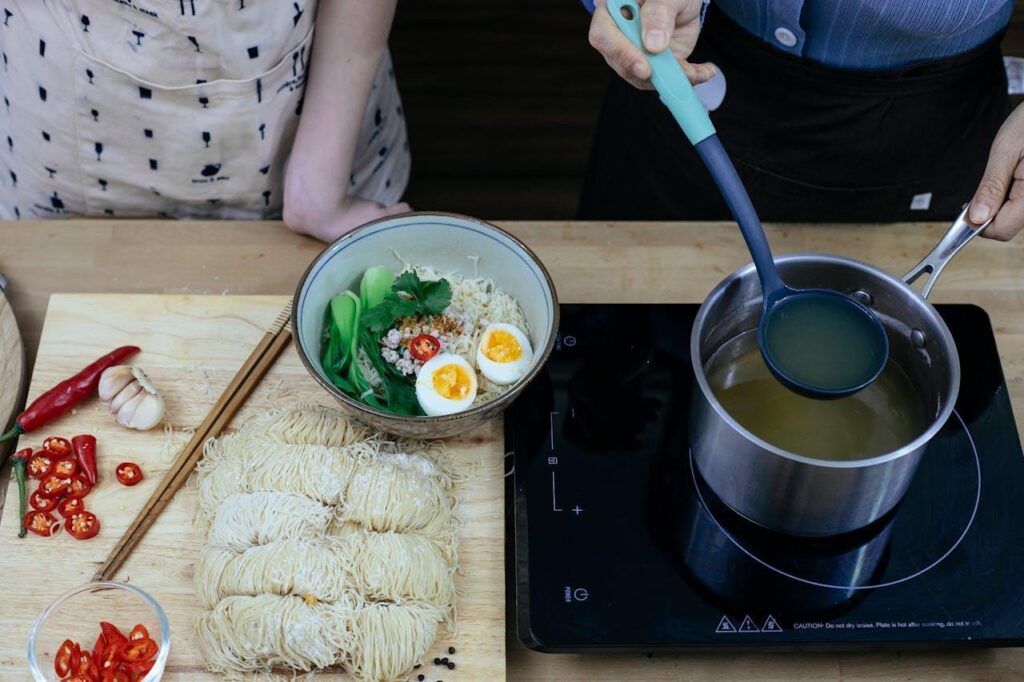Think Japanese cuisine is too complicated to whip up at home? Think again! While sushi artistry and intricate kaiseki meals have their place, everyday Japanese cooking is all about simplicity, balance, and wholesome ingredients.
Traditional dishes often use minimal oils and fats. Instead, they focus on fresh produce, lean proteins, and fermented seasonings like soy sauce and miso.
Ready to bring some delicious simplicity into your kitchen? We’ve got you covered with various recipes perfect for everyday cooking.
Essential Japanese Pantry Staples

Stocking your pantry with essential Japanese ingredients can open up a world of culinary possibilities, making it easier to recreate authentic flavors in your kitchen.
Basic seasonings
- Soy sauce: A cornerstone of Japanese cooking, this fermented soybean sauce adds depth and umami to various dishes. It’s a cornerstone of Japanese cuisine.
- Miso paste: A fermented soybean paste that comes in various types: light (white, yellow), dark (red), and darker miso, richer in flavor.
- Mirin: A sweet rice wine with a mild sweetness and subtle acidity to sauces and glazes.
- Dashi: A fundamental broth made from kombu (dried kelp) and bonito flakes (dried fish), serving as the base for many soups and stews.
- Rice vinegar: Milder and slightly sweeter than Western vinegar, perfect for dressings and pickling.
- Sesame oil: This aromatic oil’s nutty flavor can elevate stir-fries, salads, and marinades.
Read: A Data-Driven Look at Austin’s Food Truck Scene
Staples
- Short-grain rice: Known for its sticky texture, it’s the foundation of many Japanese meals.
- Nori (seaweed): Dried seaweed sheets used for wrapping sushi or as a garnish.
- Bonito flakes: Thin shavings of dried, fermented fish add a smoky, umami punch to the dishes.
- Pickled ginger: Often served with sushi, it cleanses the palate and adds a zesty kick.
Easy-to-find alternatives
If you have a hard time sourcing the ingredients above, here are some substitutes:
- Dashi: While you typically make traditional dashi from scratch, you can use high-quality store-bought broths as an alternative. Brands like Swanson stocks are favored for their consistent flavor, and you can enhance them with aromatics or a splash of soy sauce to mimic dashi’s depth.
- Mirin: Mixing dry sherry or white wine with sugar can replicate mirin’s sweetness and acidity.
- Miso paste: A small amount of soy sauce can provide some umami flavor if miso is unavailable. But it won’t replicate miso’s unique taste and texture.
Quick and Easy Japanese Recipes to Try at Home
See how those ingredients blend well together in the following dishes.
Breakfast: tamago kake gohan (egg over rice)
Tamago kake gohan, or TKG, is a no-cook Japanese breakfast meal that epitomizes simplicity and comfort. It combines hot rice with a raw egg and soy sauce, resulting in a creamy, savory, quick, and satisfying meal.
Ingredients:
- 1 bowl of freshly cooked hot rice
- 1 fresh raw egg
- Soy sauce, to taste
Optional toppings:
- Furikake (a Japanese seasoning mix)
- Chopped green onions
- Nori (seaweed) strips
- Sesame seeds
Preparation tips for the best texture:
- Use the freshest eggs because they’re consumed raw in this dish. In Japan, raw eggs are edible due to strict hygiene standards. If you’re elsewhere, consider using pasteurized eggs for safety.
- Crack the egg directly on the rice or whisk it separately for a creamier texture. Whisk until the yolk and white are well mixed and slightly foamy.
- Make a small well in the center of your hot rice to hold the egg mixture and help it distribute evenly.
- Pour the whisked egg into the well, add soy sauce to taste, and mix until the rice is creamy.
- Add toppings like furikake, chopped green onions, nori strips, or sesame seeds for extra flavor and texture.
Comfort food: oyakodon (chicken & egg rice bowl)
Oyakodon (parent and child bowl) is a Japanese comfort dish that combines tender chicken (the parent) and soft-cooked eggs (the child) on a bed of steamed rice.
Ingredients:
- 2 cups steamed Japanese short-grain rice
- 1/2 pound boneless, skinless chicken thighs in bite-sized pieces
- 1/2 onion, thinly sliced
- 2 large eggs, lightly beaten
- 1/2 cup dashi stock (or substitute with chicken broth)
- 2 tablespoons soy sauce
- 2 tablespoons mirin
- 1 tablespoon sake (optional)
- 1 teaspoon sugar
- Chopped green onions or mitsuba (Japanese parsley) for garnish
Step-by-step instructions
- Mix dashi, soy sauce, mirin, sake (optional), and sugar in a bowl until it dissolves.
- Pour half the prepared broth into a medium-sized pan, simmer over medium heat, and add sliced onions. Cook until translucent.
- Place the chicken pieces in the pan, submerging them in the broth. Cover and let it simmer for 5-7 minutes until cooked.
- Pour the eggs over the chicken and onions. Cover and cook for 1-2 minutes until the eggs are set.
- Serve steamed rice in bowls and slide the chicken and egg mixture on top. Garnish with green onions or mitsuba.
Customization options:
- For a vegetarian twist, replace chicken with firm tofu or fried beancurd rolls. These alternatives absorb the savory broth beautifully and offer a delightful texture.
- If you’re a pescatarian, use shrimp or fish fillets instead of chicken. Adjust cooking times accordingly to ensure the seafood is perfectly cooked.
Quick snack: onigiri (Japanese rice balls)
The Japanese cherish onigiri for their simplicity, versatility, and portability. You can fill these handheld snacks with various ingredients, making them delicious and customizable.
Crafting onigiri:
- Use freshly cooked Japanese short-grain rice for optimal stickiness.
- Lightly wet your hands to prevent sticking, and add some salt for extra flavor.
- Place a portion of rice in your palm, add your chosen filling, and gently mold it into your desired shape. Apply even pressure to ensure it holds together.
Pro tip: For mess-free shaping, use plastic wrap. Put the rice and filling on it, gather the edges, and shape it easily. This technique simplifies the process and maintains hygiene.
Noodle dish: yasai yaki udon (vegetable stir-fried udon)
Yasai yaki udon features thick, chewy udon noodles and a medley of vegetables. This dish is flavorful and quick to prepare, perfect for a weeknight meal.
To prevent sticking, boil udon noodles as per package instructions. After boiling, rinse them under cold water to halt cooking and remove excess starch.
Customization ideas:
- You can incorporate any vegetables on hand—bell peppers, mushrooms, cabbage, or carrots all work wonderfully.
- You can enhance the dish by adding tofu, tempeh, or seitan for a protein boost.
Dessert: dorayaki (Japanese pancakes with red bean filling)
Dorayaki is a confection consisting of two fluffy, honey-infused pancakes enveloping a sweet filling, traditionally anko (red bean paste). This treat gained international fame as the favorite snack of Doraemon, the iconic anime character.
Preparation steps:
- Whisk eggs and sugar until pale, then mix in honey. Sift in and stir flour and baking powder until smooth. Let it rest for 15 minutes.
- Heat a non-stick skillet over medium-low heat. Pour small amounts of batter into pancakes, cooking until bubbles appear on the surface. Flip and cook briefly on the other side.
- Cool the pancakes, add filling to one, and top with another to make a sandwich.
Alternative fillings:
- Custard cream for a creamy texture and mild sweetness.
- Nutella adds a rich chocolate flavor.
- Peanut butter offers a savory-sweet contrast.
Pro Tips for Stress-Free Japanese Cooking
Here are some other ways to make cooking Japanese food at home easy and fun:
- Embrace mise en place
Mise en place (putting in place) means prepping and organizing all ingredients before cooking. It makes cooking faster, less stressful, and more efficient.
- Equip your kitchen with essential tools
Investing in key kitchen tools can make Japanese cooking easier. A good rice cooker makes perfect rice effortlessly, a sharp knife helps with precise cuts, and a non-stick pan works great for stir-fries and pancakes.
- Utilize convenient shortcuts
Using store-bought items saves time without losing flavor. For example, instant dashi granules make a quick soup base, and frozen udon noodles are easy to prepare while keeping a great texture.
Bringing Japan to Your Kitchen
Exploring Japanese cuisine at home is both rewarding and accessible. From the comforting warmth of Oyakodon to the versatile delight of onigiri, the recipes above showcase the essence of Japanese cuisine. They also reflect Japan’s deep connection to nature and tradition. Hosting a Japanese cooking night is a great way to improve your skills and enjoy the culture behind each dish. Remember, Japanese cuisine is beyond the food—it’s also about the care and joy that go into making and sharing it.




